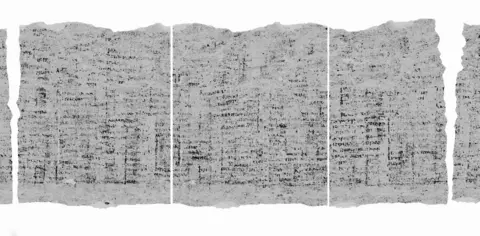
A badly burnt scroll from the Roman town of Herculaneum has been digitally "unwrapped," offering the first glimpse inside in 2,000 years.
The document, which resembles a lump of charcoal, was charred by the volcanic eruption of Mount Vesuvius in 79 AD and is too fragile to be physically opened.
However, scientists have now used a combination of X-ray imaging and artificial intelligence to virtually unfurl it, revealing rows and columns of text.
More work is needed to make the scroll fully readable and decipher its contents, but the team behind the project says the results are very promising. "We're confident we will be able to read almost the entire scroll, and it's the first time we've been able to say that with high confidence," said Stephen Parsons, project lead for the Vesuvius Challenge, an international competition aiming to unlock the Herculaneum scrolls.
Some letters are already clearly visible in the ancient text, and the team believes it is a work of philosophy. Hundreds of carbonized scrolls were discovered in Herculaneum, which, like its neighbor Pompeii, was buried under meters of volcanic ash.
In the past, some of these documents, made from a thick paper-like material called papyrus, were opened but crumbled into pieces.
The University of Oxford's Bodleian Library holds several of these scrolls. Thought to be unreadable, they had been left untouched for decades.
"We've never been convinced before that any of the techniques would be safe or effective enough to get any information from the scrolls," explained Nicole Gilroy, head of book conservation.
But the promise of a high-tech solution prompted the team to take one of the precious scrolls out of storage.
